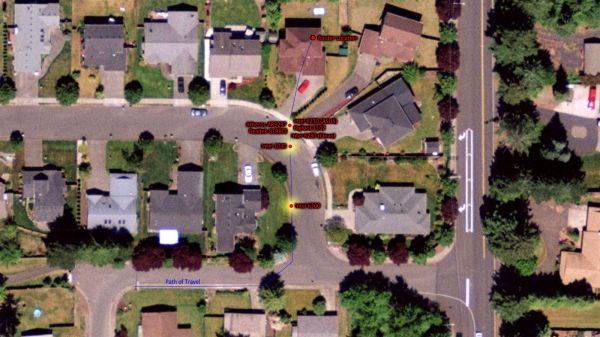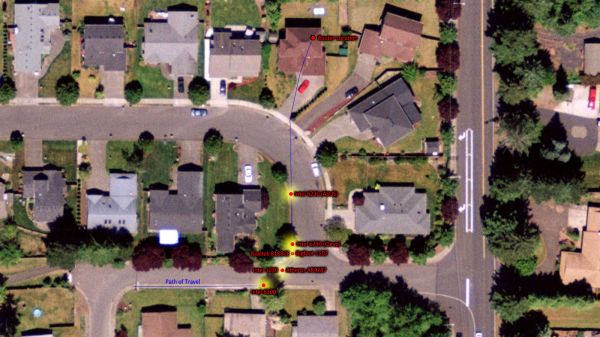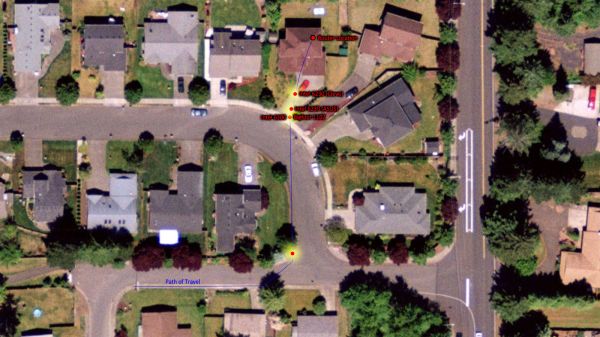Bigfoot’s Killer-N 1102 Wireless Networking vs. the World
by Jarred Walton on August 10, 2011 10:38 AM ESTTesting Signal Range
Throughput and latency are only two elements of wireless performance. Another important metric is how far a device can be from the router/access point before it drops the signal. For the Linksys E4200 router, we tested 2.4GHz and 5GHz performance with the other radio disabled (since we didn’t want the 5GHz capable laptops switching to 2.4GHz when the signal got weak). The routers were located in my office (one at a time) and I proceeded to walk out the front door with each laptop, closing the metal door behind me. It’s about 40 feet from the router to the front door (not in a direct line), and then I walked down the driveway and out into the street. I’ve created plots showing where I walked and how far I could go with each router and laptop combination. We’ll start with the Netgear results.
The vast majority of the laptops started having connection issues just past the end of my driveway. In fact, only two laptops did noticeably better, and one of those was only just barely better. The Intel 1030 maintained a connection about 20 feet further out than the other wireless devices, though throughput was understandably low (less than 5Mbps). The clear winner however is the Intel 6300. The third stream is almost certainly helping here with MRC, and perhaps the antenna and/or drivers have something to do with the performance as well. Regardless of the reason, the 6300 holds onto the wireless signal a good 60 feet farther than the 1030, and about 80 feet farther than the other wireless devices.
Moving to the Linksys E4200 and using the 2.4GHz radio, the results are substantially better than with the Netgear, thanks to a more powerful radio. Intel’s 6300 again goes the farthest before dropping out, reaching over 200 feet, likely thanks to the three spatial streams/antenna chains. The Atheros and Intel 1030 place second, just ~15 feet shy of the 6300, and Bigfoot’s 1102 and Realtek’s 8188CE are another ~15 feet behind the Atheros. Given the performance elsewhere, we weren’t particularly surprised to see Intel’s 6230 having the lowest coverage area, but it was a surprise to find that the ASUS K53E didn’t reach as far as the Clevo W150HR. Even though the K53E has worse coverage, keep in mind that it still works well in my entire yard and most of the neighboring houses—the latter point being good or bad, depending on whether you like sharing your wireless network.
When we shift over to a 5GHz signal, range drops significantly, providing even less coverage than the Netgear router. Higher frequency signals don’t propagate nearly as far, which can actually be beneficial for home environments—if all of my neighbors were using 5GHz wireless networks, I’d be lucky to see much less connect to any of them! This is one reason all the 5GHz capable cards perform so much better on a 5GHz network: lack of interference from neighboring networks (and microwaves, cordless phones, etc.). Of course, if you want a larger coverage area, even the worst result on 2.4GHz is about twice as far from the router as the best 5GHz result. Interesting to note is that in 5GHz testing, the Bigfoot 1102 actually has the best throughput out to near the end of my drive, pushing over 30Mbps until the last 5-10 feet. The cutoff point for 5GHz is really abrupt, and again that’s either good or bad depending on your intended use.
If reception at the limits of your wireless signal is important to you, the Intel 6300 appears to be the best bet (though potentially other 3x3:3 solutions might post similar results). However, we also need to consider throughput. Even though all of the devices technically maintained a 2.4GHz signal to the end of my driveway, I consider ~10Mbps of throughput to be the cutoff point for my purposes. In that case, right about where the red vehicle is parked is where I’d start getting irritated on the Netgear router, and maybe to the end of my driveway with the Linksys—except for the Intel 6300, which can go another 40 feet or so before dropping below 10Mbps. In general, even though some of the cards went farther before dropping the connection (or losing packets), throughput is much lower beyond the (metal) front door. All of the cards manage about 20-40Mbps inside the house, but close the front door and that quickly drops to 10-20Mbps. While that’s still faster than most Internet connections, latency starts to increase as well and periodic dropped packets become a concern.













52 Comments
View All Comments
DesktopMan - Wednesday, August 10, 2011 - link
What's the reason for the big difference with these results: http://www.smallnetbuilder.com/wireless/wireless-r...Anyone know?
Reflex - Wednesday, August 10, 2011 - link
Probably different laptops. This review is unfortunatly not very good because if I'm reading the first couple pages correctly, he used different laptops for each card. Contrary to his earlier experience, most laptops will accept any wifi card you wish. I swapped in a 6300 in my Dell a year ago and it works great.They need to establish a baseline testing platform to isolate the perf between the cards. Testing them all on different laptops invalidates the test. Hard drives, CPU's, memory speed, etc can have a *huge* impact on wifi performance, especially for file copy type operations. And the range test is completely irrelevant as everyone has their own way of routing the antennas up through the lid.
JarredWalton - Wednesday, August 10, 2011 - link
For wireless, the storage actually matters almost not at all. I swapped in an HDD to one of the laptops and ran the two file copy tests. The HDD was withing 1 second of the SSD for the large file, and within 3 seconds on the small files. On GbE, HDD vs. SSD is a huge disparity, but with WiFi topping out at <30MBps it really doesn't matter much. The WiFi latency appears to be almost as bad as the HDD latency for seek operations.But you're right: the different laptops all make it hard to to apples-to-apples, and depending on vendor swapping in a different WiFi card may or may not work. The real issue for me was lack of time; I kept going back and forth between devices as I discovered a potential issue with one of the results. Now that I'm more comfortable with what WiFi testing entails, I'm hoping (not right now, but maybe in a couple months) to go through and test a bunch of cards in a single laptop, as well as in a PCI-E x1 desktop adapter.
endrebjorsvik - Sunday, August 14, 2011 - link
This puzzles me as well. The last couple of days I have been struggling with getting decent performance from my own setup. I have a Netgear WNDR3700v2 and a Lenovo X220 fitted with i5-2520M and Intel 6300 3x3 and running W7. A HP ProLiant ML110 G6 with GbE and 4x2TB RAID-Z is serving the test-files.According to smallnetbuilder.com, the WNDR3700v2 ( http://www.smallnetbuilder.com/wireless/wireless-r... ) should be faster than WNR3500L ( http://www.smallnetbuilder.com/wireless/wireless-r... ), so my setup should at least be as fast as Jarred's Netgear-Intel6300-Ideal-result (154 Mb/s).
I have tried both 2,4 and 5 GHz with both 20 and 40 MHz BW and with both stock and open firmware (dd-wrt), but I don't even get to 90 Mb/s (Windows file transfer tops out at 11 MB/s = 88 Mb/s, and usually stays below 10 MB/s). The distance between the router and laptop is ~6 feet, and I have tried every possible position of the router (different antenna directions). The laptop lid is open (~90 degrees).
So I wonder if you (Jarred) came across any mindblowing tricks that increased the throughput dramatically? Or was the Netgear-Intel6300-combo just plug'n'play?
JarredWalton - Sunday, August 21, 2011 - link
What are you copying from? 11MB/s max sounds like you've got the Ethernet side hooked up to a 100Mb port, or else you're doing a transfer from one wireless PC to another? In that case, you'd be doing 22MB/s of wireless traffic, which would be pretty good considering collisions and such.ss284 - Wednesday, August 10, 2011 - link
It would have been really great if a recent macbook's wireless throughput was tested. I believe all the recent refreshes have the same broadcom based wireless adapter.xdrol - Wednesday, August 10, 2011 - link
"the number of streams cannot be more than the larger of the transmit/receive chains (so 2x2:3 isn’t possible, but 2x3:3 is)"No it is not. It cannot be more than the SMALLER of the two. But the transmit and receive antennas are on a different device, so a given device could support more than it's Tx/Rx antennas, but only in the other direction (where it does have more antennas).
As for specifying what 1 given device can do, then there are actually 4 different numbers, 3 are not enough:
- The number of Tx antennas (a)
- The number of spatial streams to be received (<=a)
- The number of Rx antennas (b)
- The number of spatial streams to be transmitted (<=b)
As WiFi is a symmetrical system, the Tx and Rx features of a device are usually the same (read: I'm yet to see any that differ) - unlike e.g. LTE, where the usual MIMO currently is only downlink, but not uplink (it has different PHY for uplink anyway).
In the example, the 2x3:3 is valid only if you meant it has 2 Tx antennas, 3 Rx antennas, and it can RECEIVE 3 spatial streams. As it has only 2 antennas, the maximum outbound spatial streams is 2.
Brian Klug - Wednesday, August 10, 2011 - link
That's technically right, and we do mention that the Intel 1030 can do two streams on Rx and one on Tx, but I've seen very few routers actually support an asymmetrical MIMO scheme like that. Even the intel card for example always only shows 1 stream being used for Tx and Rx, so in practice really it should be symmetrical.-Brian
James5mith - Wednesday, August 10, 2011 - link
Maybe I'm used to living in smaller places, but 60 feet from your front door to the router? That seems a bit extreme. Is the router in the attic, and the front door in the basement corner of the house or something?James5mith - Wednesday, August 10, 2011 - link
Actually, more to the point, if it's 60 ft to your front door, then your google maps view shows the Intel 6300 making it nearly 500 ft from the router in the Cisco 2.4GHz test. You stated it was 200 ft.